St Andrew's Uniting (Presbyterian) Kirk
Sturt Street, Ballarat
First organ, moved to Holy Trinity Anglican Church, Kew
Present organ, B 1891 Fincham & Hobday. 3m, 24spst, 5c, tr.
Gt: 16.8.8.8.4.4.2-2/3.2. Sw: 16.8.8.8.4.2.III.8.8. Ch: 8.8.8.4.2. Ped: 16.16.
Reb & enl 1926 Geo Fincham & Sons. 3m, 40spst, 10c, tubpn.
Console disconnected and organ out of use 1991.
Gt: 16.8.8.8.8.4.4.2-2/3.2.8. Sw: 16.8.8.8.8.4.2.III.8.8.8.
Ch: 8.8.8.8.4.4.2.8.8. 8.8. Ped: 32.16.16.16.8.8.8. 8.
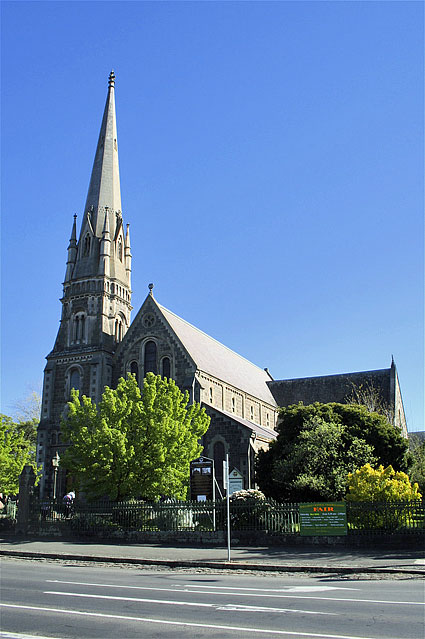
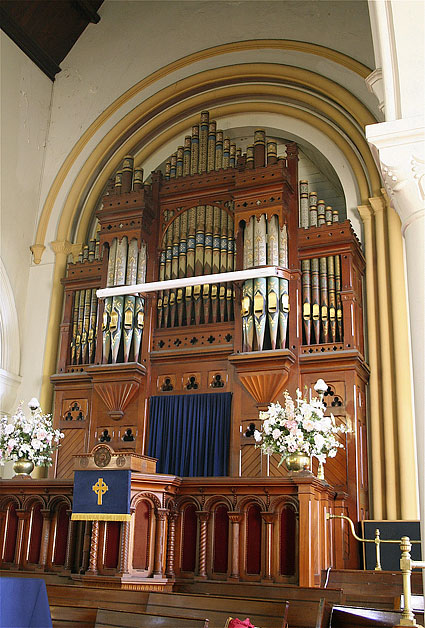
The St Andrew’s congregation was founded in 1854 and initially met in a wooden church opened in 1858. The present church was designed by Ballarat architect C.D. Cuthbert, and is one of the largest churches in Victoria designed in the Romanesque style. Construction began in 1862-64 and at later stages the porch and vestry were added, in 1873, the tower and spire, in 1882-84 (the latter in Gothic idiom), the transepts, in 1890 and the apsidal choir vestry, in 1926 (not unlike that at the Thomson Memorial Church, Terang).
The building consists of a lofty clerestoried nave with arches resting on cushion capitals separating it from the aisles. There are very wide transepts. It is constructed in bluestone and has elaborate stone carving around the main doorway. The interior includes outstanding fittings, many in the Romanesque style, especially the pews, pulpit and the stained glass, some by Ballantine of Edinburgh.
This is a remarkably ambitious building for the period and at the end of the 19th century would have been amongst the largest of its denomination in Victoria.
The first organ was built for the church by Mackenzie & Company in 1874 at a cost of £525. The organ proved to be unsatisfactory and was rebuilt in 1878 by George Fincham with new soundboards, action and pipework repairs. The instrument was placed in the south gallery, above the entrance. This instrument was sold to Fincham & Hobday in 1891. It was hired to the Presbyterian Church, Essendon in June 1894 and in 1898 it was bought by Holy Trinity Anglican Church, Kew, where it has since been rebuilt and altered on three occasions. The 1874 specification was:
GREAT |
8 8 8 8 4 4 2-2/3 2 II 8 8 8 8 4 2 II 8 8 16 16 |
CC-BB TC [TC?] [gvd.bass?] |
Mechanical action
3 composition pedals
A new three-manual organ of 24 speaking stops and mechanical action was built for St Andrew’s Kirk by Fincham & Hobday and opened on 26 January 1891. The cost was £1,026 less £176 allowed for the old organ. It was centrally placed within an archway and incorporated an outstanding casework, with Gothic detailing, and splendidly decorated façade pipes.
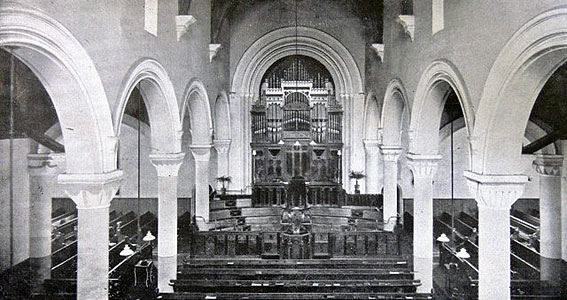
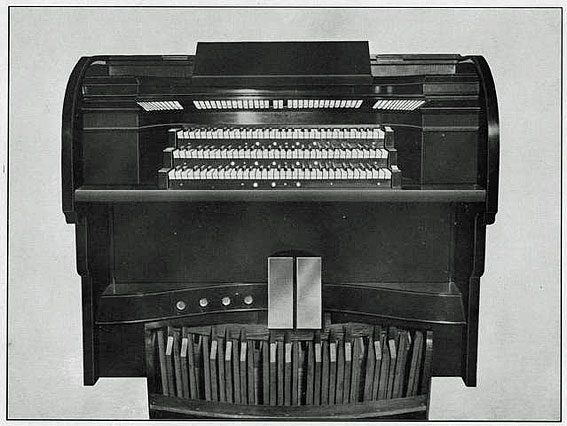
The specification was as follows:
GREAT |
16 8 8 8 4 4 2-2/3 2 16 8 8 8 4 2 III 8 8 8 8 8 4 2 16 16 |
wood TC [gvd.bass?] [unenclosed?] wood |
Compass: 56/30
In 1926 this instrument was rebuilt and enlarged by George Fincham & Sons Pty Ltd, making it the largest organ in Ballarat. The action was converted to tubular-pneumatic, a new detached stopkey console supplied, and a number of new ranks installed in what was an unreasonably small space. The Great Tromba and Swell Vox Humana were supplied by Frank Wesson, of London, and ordered on the advice of Mr Barber, one of the firm’s employees. The console was fitted with the firm’s stop control tablets that enabled registrations to be held and reset when the tablet was depressed, reverting to the next combination when the tablet was raised.
Leighton Turner carried on renovations to the instrument so that in the mid 1980s it was all fully playable. However, since his death maintenance discontinued and an electronic substitute has been in use since the early 1990s, the speakers placed within Fincham & Hobday’s delightful casework. The 1926 console has been disconnected and removed.
GREAT |
16 8 8 8 8 4 4 2-2/3 2 8 16 8 8 8 8 4 2 III 8 8 8 8 8 8 8 4 4 2 8 8 8 8 32 16 16 16 8 8 8 8 |
1926: separate chest A 1926: on separate chest; 6” wind B C 1926 TC 1926 17.19.22 1926 (enclosed) gvd.bass 1926 1926 1926 1926 A B [D?] Wood D E C A D E B |
Compass: 61/30
Balanced mechanical swell pedals to Swell and Choir
4 thumb pistons to Great
4 thumb pistons to Swell
3 thumb pistons to Choir
4 toe pistons
Piston reducing organ to no 1 combinations
Swell to Great reversible tablet
Great to Pedal reversible tablet
Victorian Churches, edited by Miles Lewis. East Melbourne: National Trust of Australia (Victoria), 1991, p.97
E.N. Matthews, Colonial Organs and Organbuilders. Carlton: Melbourne University Press, 1969, pp. 132, 139, 160, 208
Specification of the 1891 organ from the George Fincham letters, State Library of Victoria
Specification of 1926 organ supplied by John N. Cowan (organist of the church 1940s and 1950s).
Console illustration from Organs of the Catholic Church. Richmond: George Fincham & Sons Pty Ltd, 1931.
John Maidment
22 October 2008
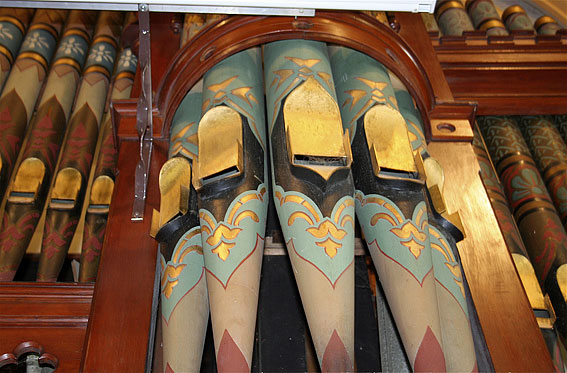
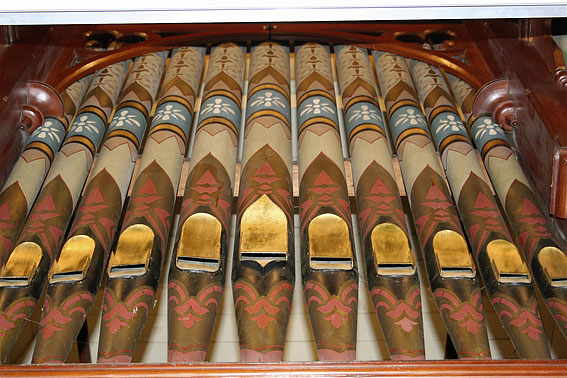
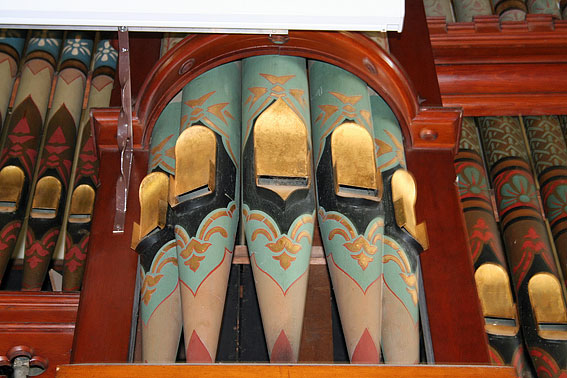

Photo: Trevor Bunning (October 2008)